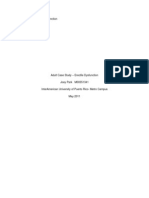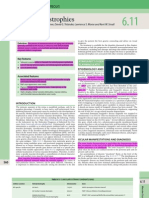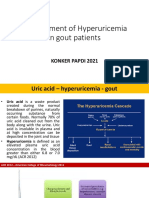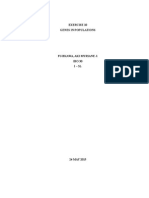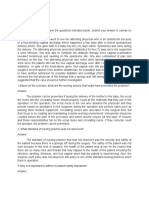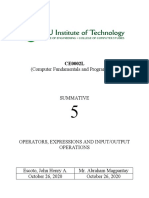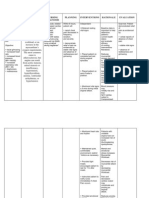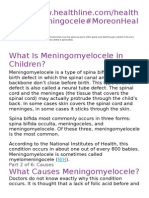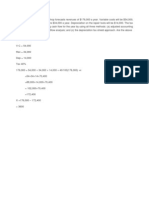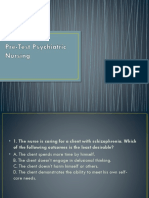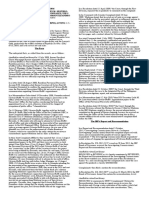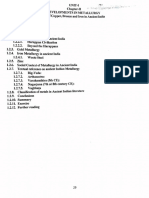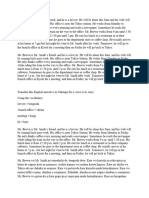0%(1)0% found this document useful (1 vote)
437 viewsAbg Quiz
Abg Quiz
Uploaded by
Defensor Pison GringgoThis document contains 10 multiple choice questions about interpreting arterial blood gas (ABG) results. Each question provides clinical information about a patient and their ABG values including pH, PaCO2, HCO3, and sometimes other electrolyte levels. Respondents are asked to identify the underlying acid-base disorder based on the given ABG results and patient presentation.
Copyright:
© All Rights Reserved
Available Formats
Download as PPTX, PDF, TXT or read online from Scribd
Abg Quiz
Abg Quiz
Uploaded by
Defensor Pison Gringgo0%(1)0% found this document useful (1 vote)
437 views11 pagesThis document contains 10 multiple choice questions about interpreting arterial blood gas (ABG) results. Each question provides clinical information about a patient and their ABG values including pH, PaCO2, HCO3, and sometimes other electrolyte levels. Respondents are asked to identify the underlying acid-base disorder based on the given ABG results and patient presentation.
Original Description:
ABG
Original Title
ABG QUIZ
Copyright
© © All Rights Reserved
Available Formats
PPTX, PDF, TXT or read online from Scribd
Share this document
Did you find this document useful?
Is this content inappropriate?
This document contains 10 multiple choice questions about interpreting arterial blood gas (ABG) results. Each question provides clinical information about a patient and their ABG values including pH, PaCO2, HCO3, and sometimes other electrolyte levels. Respondents are asked to identify the underlying acid-base disorder based on the given ABG results and patient presentation.
Copyright:
© All Rights Reserved
Available Formats
Download as PPTX, PDF, TXT or read online from Scribd
Download as pptx, pdf, or txt
0%(1)0% found this document useful (1 vote)
437 views11 pagesAbg Quiz
Abg Quiz
Uploaded by
Defensor Pison GringgoThis document contains 10 multiple choice questions about interpreting arterial blood gas (ABG) results. Each question provides clinical information about a patient and their ABG values including pH, PaCO2, HCO3, and sometimes other electrolyte levels. Respondents are asked to identify the underlying acid-base disorder based on the given ABG results and patient presentation.
Copyright:
© All Rights Reserved
Available Formats
Download as PPTX, PDF, TXT or read online from Scribd
Download as pptx, pdf, or txt
You are on page 1of 11
At a glance
Powered by AI
The document discusses several case studies and their arterial blood gas (ABG) interpretations.
Respiratory Acidosis, Partially Compensated
Metabolic Acidosis, Partially Compensated
ABG QUIZ
• 1. George Kent is a 54 year old widower with a history of
chronic obstructive pulmonary disease and was rushed to
the emergency department with increasing shortness of
breath, pyrexia, and a productive cough with yellow-
green sputum. He has difficulty in communicating
because of his inability to complete a sentence. One of
his sons, Jacob, says he has been unwell for three days.
Upon examination, crackles and wheezes can be heard in
the lower lobes; he has a tachycardia and a bounding
pulse. Measurement of arterial blood gas shows pH 7.3,
PaCO2 68 mm Hg, HCO3 28 mmol/L, and PaO2 60 mm Hg.
How would you interpret this?
• A. Respiratory Acidosis, Uncompensated
B. Respiratory Acidosis, Partially Compensated
C. Metabolic Alkalosis, Uncompensated
D. Metabolic Acidosis, Partially Compensated
• 2. Carl, an elementary student, was rushed to the
hospital due to vomiting and a decreased level of
consciousness. The patient displays slow and deep
(Kussmaul breathing), and he is lethargic and irritable
in response to stimulation. He appears to be
dehydrated—his eyes are sunken and mucous
membranes are dry—and he has a two week history
of polydipsia, polyuria, and weight loss.
Measurement of arterial blood gas shows pH 7.0,
PaO2 90 mm Hg, PaCO2 23 mm Hg, and HCO3 12
mmol/L; other results are Na+ 126 mmol/L, K+ 5
mmol/L, and Cl- 95 mmol/L. What is your
assessment?
• A. Respiratory Acidosis, Uncompensated
B. Respiratory Acidosis, Partially Compensated
C. Metabolic Alkalosis, Uncompensated
D. Metabolic Acidosis, Partially, Compensated
• 3. A cigarette vendor was brought to the
emergency department of a hospital after she
fell into the ground and hurt her left leg. She is
noted to be tachycardic and tachypneic.
Painkillers were carried out to lessen her pain.
Suddenly, she started complaining that she is
still in pain and now experiencing muscle
cramps, tingling, and paraesthesia.
Measurement of arterial blood gas reveals pH
7.6, PaO2 120 mm Hg, PaCO2 31 mm Hg, and
HCO3 25 mmol/L. What does this mean?
• A. Respiratory Alkalosis, Uncompensated
B. Respiratory Acidosis, Partially Compensated
C. Metabolic Alkalosis, Uncompensated
D. Metabolic Alkalosis, Partially Compensated
• 4. Ricky’s grandmother is suffering from
persistent vomiting for two days now. She
appears to be lethargic and weak and has
myalgia. She is noted to have dry mucus
membranes and her capillary refill takes >4
seconds. She is diagnosed as having
gastroenteritis and dehydration. Measurement
of arterial blood gas shows pH 7.5, PaO2 85 mm
Hg, PaCO2 40 mm Hg, and HCO3 34 mmol/L.
What acid-base disorder is shown?
• A. Respiratory Alkalosis, Uncompensated
B. Respiratory Acidosis, Partially Compensated
C. Metabolic Alkalosis, Uncompensated
D. Metabolic Alkalosis, Partially Compensated
• 5. Mrs. Johansson, who had undergone surgery in the
post-anesthesia care unit (PACU), is difficult to arouse
two hours following surgery. Nurse Florence in the
PACU has been administering Morphine Sulfate
intravenously to the client for complaints of post-
surgical pain. The client’s respiratory rate is 7 per
minute and demonstrates shallow breathing. The
patient does not respond to any stimuli! The nurse
assesses the ABCs (remember Airway, Breathing,
Circulation!) and obtains ABGs STAT! Measurement of
arterial blood gas shows pH 7.10, PaCO2 70 mm Hg
and HCO3 24 mEq/L. What does this mean?
• A. Respiratory Alkalosis, Partially Compensated
B. Respiratory Acidosis, Uncompensated
C. Metabolic Alkalosis, Partially Compensated
D. Metabolic Acidosis, Uncompensated
• 6. Baby Angela was rushed to the Emergency
Room following her mother’s complaint that the
infant has been irritable, difficult to breastfeed
and has had diarrhea for the past 3 days. The
infant’s respiratory rate is elevated and the
fontanels are sunken. The Emergency Room
physician orders ABGs after assessing the ABCs.
The results from the ABG results show pH 7.39,
PaCO2 27 mmHg and HCO3 19 mEq/L. What
does this mean?
• A. Respiratory Alkalosis, Fully Compensated
B. Metabolic Acidosis, Uncompensated
C. Metabolic Acidosis, Fully Compensated
D. Respiratory Acidosis, Uncompensated
• 7. Mr. Wales, who underwent post-abdominal
surgery, has a nasogastric tube. The nurse on
duty notes that the nasogastric tube (NGT) is
draining a large amount (900 cc in 2 hours) of
coffee ground secretions. The client is not
oriented to person, place, or time. The nurse
contacts the attending physician and STAT ABGs
are ordered. The results from the ABGs show pH
7.57, PaCO2 37 mmHg and HCO3 30 mEq/L.
What is your assessment?
• A. Metabolic Acidosis, Uncompensated
B. Metabolic Alkalosis, Uncompensated
C. Respiratory Alkalosis, Uncompensated
D. Metabolic Alkalosis, Partially Compensated
• 8. Client Z is admitted to the hospital and is to
undergo brain surgery. The client is very anxious
and scared of the upcoming surgery. He begins
to hyperventilate and becomes very dizzy. The
client loses consciousness and the STAT ABGs
reveal pH 7.61, PaCO2 22 mmHg and HCO3 25
mEq/L. What is the ABG interpretation based on
the findings?
• A. Metabolic Acidosis, Uncompensated
B. Respiratory Alkalosis, Partially Compensated
C. Respiratory Alkalosis, Uncompensated
D. Metabolic Alkalosis, Partially Compensated
• 9. Three-year-old Adrian is admitted to the
hospital with a diagnosis of asthma and
respiratory distress syndrome. The mother of
the child reports to the nurse on duty that she
has witnessed slight tremors and behavioral
changes in her child over the past four days. The
attending physician orders routine ABGs
following an assessment of the ABCs. The ABG
results are pH 7.35, PaCO2 72 mmHg and HCO3
38 mEq/L. What acid-base disorder is shown?
• A. Respiratory Acidosis, Uncompensated
B. Respiratory Acidosis, Fully Compensated
C. Respiratory Alkalosis, Fully Compensated
D. Metabolic Alkalosis, Partially Compensated
• 10. Anne, who is drinking beer at a party, falls
and hits her head on the ground. Her friend
Liza dials “911” because Anne is unconscious,
depressed ventilation (shallow and slow
respirations), rapid heart rate, and is
profusely bleeding from both ears. Which
primary acid-base imbalance is Anne at risk
for if medical attention is not provided?
• A. Metabolic Acidosis
B. Metabolic Alkalosis
C. Respiratory Acidosis
D. Respiratory Alkalosis
You might also like
- Experiment 3: Equilibrium: Laws/Atwoods-Machine/Atwoods-Machine-InteractiveDocument6 pagesExperiment 3: Equilibrium: Laws/Atwoods-Machine/Atwoods-Machine-Interactivemarie parfanNo ratings yet
- Experiment #4 - Enzymatic Reduction of Methyl AcetoacetateDocument5 pagesExperiment #4 - Enzymatic Reduction of Methyl AcetoacetateJasmin CeciliaNo ratings yet
- Human Diseases Case Study 19CDocument3 pagesHuman Diseases Case Study 19Cairickann50% (2)
- 2E-PH: Belmonte, Manalo, Sarto, YanDocument5 pages2E-PH: Belmonte, Manalo, Sarto, YananonymousNo ratings yet
- NicolasDarvas Trading System PDF PDFDocument7 pagesNicolasDarvas Trading System PDF PDFmamun beba0% (1)
- Abg Interpretation Practice TestDocument3 pagesAbg Interpretation Practice TestPatty RomeroNo ratings yet
- Case StudyDocument5 pagesCase StudyJoey ParkNo ratings yet
- Quiz Tues and ThursDocument2 pagesQuiz Tues and ThursJohn Rey Enriquez50% (2)
- Activity # 2: 1.1 Write Your Physical Assessment Using Cephalocaudal TechniqueDocument4 pagesActivity # 2: 1.1 Write Your Physical Assessment Using Cephalocaudal TechniqueAliyah Jewel JimenezNo ratings yet
- Medsurg 3Document22 pagesMedsurg 3eyesontheskyNo ratings yet
- Drug Study (Uterine Atony)Document14 pagesDrug Study (Uterine Atony)Violy CabigatNo ratings yet
- MedSurg 2Document69 pagesMedSurg 2Claire Maurice JuaneroNo ratings yet
- Teaching Demo FormatDocument5 pagesTeaching Demo FormatPeter Limjoco DavidNo ratings yet
- NCM NEURO DISORDERS ASSIGN - QDocument14 pagesNCM NEURO DISORDERS ASSIGN - QDanica Joy Vinluan JacobaNo ratings yet
- Joella Sanchez Case Study (GRP Act #5)Document2 pagesJoella Sanchez Case Study (GRP Act #5)Elle ctrica100% (2)
- NeuroDocument4 pagesNeuroKrizia R. PingkeNo ratings yet
- PNEUMODocument5 pagesPNEUMOArmin Tordecilla MercadoNo ratings yet
- RESPI QuestionsDocument15 pagesRESPI QuestionsKim Anulacion100% (2)
- Stargardt DiseaseDocument9 pagesStargardt DiseaseEstefhany SCNo ratings yet
- Case 1: Group 4Document26 pagesCase 1: Group 4John Joshua Lacson MedicineNo ratings yet
- Chem 415 Experiment 1Document6 pagesChem 415 Experiment 1ttussenoNo ratings yet
- 0 - Management of HyperuricemiaDocument44 pages0 - Management of HyperuricemiaYayuk Abay TambunanNo ratings yet
- Bio 30 - Exercise 10Document8 pagesBio 30 - Exercise 10akifuji913No ratings yet
- NCP Diabetes MellitusDocument2 pagesNCP Diabetes MellitusrhueneisenNo ratings yet
- Ineffective Airway ClearanceDocument9 pagesIneffective Airway ClearanceFatiha Sri Utami TamadNo ratings yet
- Basic Skills in SwimmingDocument3 pagesBasic Skills in SwimmingTakumi Shawn HinataNo ratings yet
- NCM 118 - Lesson 3 (Pulmonary Embolism)Document4 pagesNCM 118 - Lesson 3 (Pulmonary Embolism)Bobby Christian DuronNo ratings yet
- Care PlanDocument4 pagesCare Planapi-217086261No ratings yet
- NCP For BreathingDocument17 pagesNCP For BreathingCeleste Sin Yee100% (1)
- Franco, Danica A. CU3Document2 pagesFranco, Danica A. CU3Danica FrancoNo ratings yet
- Lecturer: Idol L. Bondoc, M.D.,R.NDocument58 pagesLecturer: Idol L. Bondoc, M.D.,R.NidolbondocNo ratings yet
- NCM 104 Midterm121410Document15 pagesNCM 104 Midterm121410Khristoffer Nebres100% (1)
- RESPI QuestionDocument14 pagesRESPI QuestionCarmela Marie Eriguel CuetoNo ratings yet
- Neuro Nursing HandoutsDocument33 pagesNeuro Nursing HandoutsMC Med100% (2)
- Technical Summative Assessment 5Document7 pagesTechnical Summative Assessment 5John Henry EscotoNo ratings yet
- A Kidney For Life Case Analysis Questions (Final)Document7 pagesA Kidney For Life Case Analysis Questions (Final)Ruby Jane LaquihonNo ratings yet
- NCM 118 - Lesson 6 (Pulmonary Hypertension)Document3 pagesNCM 118 - Lesson 6 (Pulmonary Hypertension)Bobby Christian DuronNo ratings yet
- RIZAL - Lesson 2Document4 pagesRIZAL - Lesson 2Samuel John CochingNo ratings yet
- NCP Format - Docx 2ndDocument4 pagesNCP Format - Docx 2ndGalileo AragonaNo ratings yet
- Physical Assessment AGE With Diarrhea FINALDocument5 pagesPhysical Assessment AGE With Diarrhea FINALMiggy MiggyNo ratings yet
- Ethical Principles of NursingDocument2 pagesEthical Principles of NursingClarissa HeatonNo ratings yet
- MeningomyeloceleDocument42 pagesMeningomyeloceleSundaraBharathiNo ratings yet
- Case Presentation About Calculous CholecyctitisDocument23 pagesCase Presentation About Calculous CholecyctitiskarenNo ratings yet
- Perception and CoordinationDocument32 pagesPerception and CoordinationFerdie Marcial B. AureaNo ratings yet
- Iloilo Psyche 2Document7 pagesIloilo Psyche 2stoto_arenNo ratings yet
- Revalida QuestionsDocument6 pagesRevalida QuestionsCarolyn Calupitan100% (1)
- F&E ExamDocument3 pagesF&E ExamDino PringNo ratings yet
- Chapter 15 BEDSIDE ASSESSMENT OF THE PATIENTDocument16 pagesChapter 15 BEDSIDE ASSESSMENT OF THE PATIENTZahra Margrette SchuckNo ratings yet
- Polytechnic University of The PhilippinesDocument3 pagesPolytechnic University of The PhilippinesFienz Karl Vallejo JavelozaNo ratings yet
- NCP - Decreased Cardiac OutputDocument3 pagesNCP - Decreased Cardiac OutputIzza DeloriaNo ratings yet
- Mechvent Review (Topnotcher)Document284 pagesMechvent Review (Topnotcher)Inimical G100% (1)
- TrigoGeom Handout AnswersDocument2 pagesTrigoGeom Handout AnswersZoroNo ratings yet
- National Gallery: Arts Appreciation Summative Assessment 2Document3 pagesNational Gallery: Arts Appreciation Summative Assessment 2Rausa MaeNo ratings yet
- The Owner of A Bicycle Repair Shop Forecasts Revenues ofDocument1 pageThe Owner of A Bicycle Repair Shop Forecasts Revenues ofPamela RainNo ratings yet
- Chapter 27 Acute Lung Injury, Pulmonary Edema and Multi Organ System FailureDocument10 pagesChapter 27 Acute Lung Injury, Pulmonary Edema and Multi Organ System FailureShanin SalapuddinNo ratings yet
- Completion2 Di Po 100 PercentDocument20 pagesCompletion2 Di Po 100 PercentJotham MorciloNo ratings yet
- Cardiovascular 4416Document5 pagesCardiovascular 4416api-3703191No ratings yet
- Community Health Nursing Exam 4Document9 pagesCommunity Health Nursing Exam 4ek.9006001No ratings yet
- Abg ExamDocument6 pagesAbg ExamericNo ratings yet
- 2Document4 pages2Emmyr JohnNo ratings yet
- Acid Base 1Document20 pagesAcid Base 1Arjun SundaramNo ratings yet
- COPAR - As Been A Strategy Used by Health Resource Distribution Program (HRDP 111) in ImplementingDocument6 pagesCOPAR - As Been A Strategy Used by Health Resource Distribution Program (HRDP 111) in ImplementingDefensor Pison Gringgo100% (1)
- Physics EOC ReviewDocument13 pagesPhysics EOC ReviewDefensor Pison GringgoNo ratings yet
- Health Declaration Card: Republic of The Philippines Province of AklanDocument1 pageHealth Declaration Card: Republic of The Philippines Province of AklanDefensor Pison GringgoNo ratings yet
- Grammar and Correct UsageDocument6 pagesGrammar and Correct UsageDefensor Pison GringgoNo ratings yet
- Physics 05-Fluids (2018)Document39 pagesPhysics 05-Fluids (2018)Defensor Pison GringgoNo ratings yet
- Physics 12-Special Relativity (2016)Document25 pagesPhysics 12-Special Relativity (2016)Defensor Pison GringgoNo ratings yet
- Pre-Test Maternal and Child Health NursingDocument18 pagesPre-Test Maternal and Child Health NursingDefensor Pison GringgoNo ratings yet
- Pre-Test Psychiatric NursingDocument17 pagesPre-Test Psychiatric NursingDefensor Pison Gringgo100% (1)
- Pre-Test Psychiatric NursingDocument17 pagesPre-Test Psychiatric NursingDefensor Pison GringgoNo ratings yet
- Maternal and Child Health Nursing Male Reproductive OrganDocument19 pagesMaternal and Child Health Nursing Male Reproductive OrganDefensor Pison GringgoNo ratings yet
- Psychiatric Nursing Bullets Neurotransmission TheoryDocument4 pagesPsychiatric Nursing Bullets Neurotransmission TheoryDefensor Pison Gringgo100% (1)
- Community Health Nursing BulletsDocument5 pagesCommunity Health Nursing BulletsDefensor Pison GringgoNo ratings yet
- FreudDocument5 pagesFreudDefensor Pison GringgoNo ratings yet
- Bon Resolution No 11Document6 pagesBon Resolution No 11Defensor Pison GringgoNo ratings yet
- Anxiety Nitroglycerin: Myocardial InfarctionDocument135 pagesAnxiety Nitroglycerin: Myocardial InfarctionDefensor Pison Gringgo0% (1)
- Pattern of MisconductDocument12 pagesPattern of MisconductDefensor Pison GringgoNo ratings yet
- Answers To Questions 21 To 30 Pract2 2Document3 pagesAnswers To Questions 21 To 30 Pract2 2Defensor Pison GringgoNo ratings yet
- Answers For Questions 30 To 40 in Pract Court 1Document3 pagesAnswers For Questions 30 To 40 in Pract Court 1Defensor Pison GringgoNo ratings yet
- Answers For Questions 30 To 40 in Pract Court 1Document3 pagesAnswers For Questions 30 To 40 in Pract Court 1Defensor Pison GringgoNo ratings yet
- Continuation Members of The Bar in Govt ServiceDocument21 pagesContinuation Members of The Bar in Govt ServiceDefensor Pison GringgoNo ratings yet
- 13.TimeTravel and FailSafeDocument10 pages13.TimeTravel and FailSafeclouditlab9No ratings yet
- HISTORY 5th SEM Unit 1 Ch2 & Ch3Document16 pagesHISTORY 5th SEM Unit 1 Ch2 & Ch3yogeshNo ratings yet
- Part-A Experiments Using Matlab: DSP Lab ManualDocument40 pagesPart-A Experiments Using Matlab: DSP Lab ManualSharth KumarNo ratings yet
- GEGsfgDocument5 pagesGEGsfgBananaHUN 22No ratings yet
- Cisco Nexus 9000 Series NX-OS VXLAN Configuration GuideDocument538 pagesCisco Nexus 9000 Series NX-OS VXLAN Configuration Guidequanghung91No ratings yet
- England in The Time of King Richard IIIDocument2 pagesEngland in The Time of King Richard IIIDébora MariniNo ratings yet
- Management Client RelationshipDocument27 pagesManagement Client RelationshipSheena Marie Añonuevo DomingoNo ratings yet
- Elementary Grammar of The Latin Language With A Series of Latin and English Exercises For Translation and A Collection of Latin Reading Lessons, With The Requisite VocabulariesDocument396 pagesElementary Grammar of The Latin Language With A Series of Latin and English Exercises For Translation and A Collection of Latin Reading Lessons, With The Requisite VocabulariesdexavoNo ratings yet
- Critical Vs Non Critical ThinkingDocument26 pagesCritical Vs Non Critical ThinkingMark Anthony LopezNo ratings yet
- Asian ArchitectureDocument35 pagesAsian ArchitectureCarlos Jr RosNo ratings yet
- Automatically Generate Packaging Items in EWMDocument9 pagesAutomatically Generate Packaging Items in EWMSandy KaliramanNo ratings yet
- Photographer Research Part 1Document2 pagesPhotographer Research Part 1mlgiltnerNo ratings yet
- Physics Project FileDocument17 pagesPhysics Project FileKunal Sagar100% (1)
- Teaching Diverse Population Syllabus - University of FloridaDocument15 pagesTeaching Diverse Population Syllabus - University of FloridaThe College FixNo ratings yet
- 9040121B OI-II Telestart T99 - ENDocument17 pages9040121B OI-II Telestart T99 - ENAndrei SereaNo ratings yet
- Form 4.3 Summary of Current Competencies Versus Required Competencies RequiredDocument3 pagesForm 4.3 Summary of Current Competencies Versus Required Competencies Requiredpia castilloNo ratings yet
- Remote Work Playbook ThoughtworksDocument13 pagesRemote Work Playbook ThoughtworksManmithNo ratings yet
- Midterm MGT 251 Fall 2021Document2 pagesMidterm MGT 251 Fall 2021MumuNo ratings yet
- Gbi Project - Sonic Tower OfficeDocument35 pagesGbi Project - Sonic Tower OfficeHazrul AimanNo ratings yet
- Tutorial 3 AnswerDocument4 pagesTutorial 3 Answershorouk salahNo ratings yet
- Sale Mix and Break Even Analysis With Multiple Products (Lecture 9 Supp Notes)Document3 pagesSale Mix and Break Even Analysis With Multiple Products (Lecture 9 Supp Notes)renakwokNo ratings yet
- Holes Study Guide Questions: Part One - You Are Entering Camp Green Lake Chapters One & TwoDocument6 pagesHoles Study Guide Questions: Part One - You Are Entering Camp Green Lake Chapters One & TwoPaulNo ratings yet
- 1191Document3 pages1191trungstatheros2904No ratings yet
- Extract From Fire Colour OneDocument38 pagesExtract From Fire Colour OneHCBourne100% (1)
- Postal Bharti July, 2013Document20 pagesPostal Bharti July, 2013secgenbpefNo ratings yet
- MR Brown NarrativeDocument2 pagesMR Brown NarrativeLila SNo ratings yet
- Application of Heat and Cool in Biology-Lozano, Nerizza Anne Q.Document16 pagesApplication of Heat and Cool in Biology-Lozano, Nerizza Anne Q.Nerizza Anne Q. LozanoNo ratings yet
- CTM Macau v6 - May 17Document4 pagesCTM Macau v6 - May 17gopiv2020No ratings yet
- IIT JEE Coordinate Geometry - Preparation Tips To Practical Applications! - askIITiansDocument19 pagesIIT JEE Coordinate Geometry - Preparation Tips To Practical Applications! - askIITiansaskiitian67% (3)






